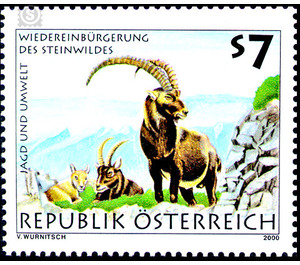Hunting and environment - Austria / II. Republic of Austria 2000 - 7 Shilling
Theme: Animals
| Country | Austria / II. Republic of Austria |
| Issue Date | 2000 |
| Face Value | 7.00 |
| Printing Type | Photogravure |
| Stamp Type | Commemorative |
| Item Type | Stamp |
| Chronological Issue Number | 1649 |
| Chronological Chapter | OOS-OE2 |
| SID | 471440 |
| In 71 Wishlists | |
Originally home to the Alpine ibex in Switzerland, Germany, France, Italy and Austria. But in the 16th century the species did not appear in many former habitats, and at the beginning of the 18th century the ibex was completely eradicated in the Austrian Alps. The animals lived a little longer in France and Switzerland; At the beginning of the 19th century, however, the ibex disappeared from the entire Alpine region. Only between 50 and 100 animals survived under strict protection in the area of the Gran Paradiso massif in northwestern Italy. Throughout the rest of the Alpine region, the impressive wild species has been eradicated by humans. The reasons for the extermination are to be sought among other things in the people and superstition, because almost every body part of the Steinwildes special forces were attributed. Today, between 24,000 and 28,000 pieces of ibex live in the entire Alpine region. The repatriation is mainly due to private initiatives of hunters. In Austria too, the first attempts at naturalization were made very early. Especially in Salzburg, the land that was inhabited by the last ibex, the first naturalization attempt was made in 1924 in the Blühnbachtal. After the Second World War, further successful settlement attempts then took place in Tyrol, Carinthia and Vorarlberg. Today, one can expect a stock of at least 3,000 animals in Austria.


